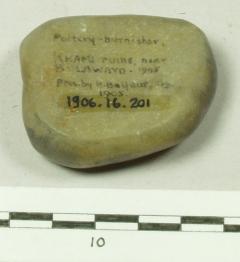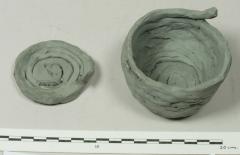ENGLAND: THE OTHER WITHIN
Analysing the English Collections at the Pitt Rivers Museum
Experimental pottery
Alison Petch,
Researcher 'The Other Within' project
Beatrice Blackwood, in her list of classifications for artefacts under the heading 'Technique', included a section on 'Experimental Pottery'. Her Occasional Paper on Technology entitled 'Classification ...' was an explanation of the way that Pitt Rivers Museum staff had defined artefacts for inclusion in the card catalogue system introduced by Penniman and Blackwood from the late 1930s. When the Technique card catalogue drawer is examined, there is only one card under this heading, for 1907.48.1-9:
D. RANDALL-MCIVER, [sic, actually David Randall MacIver] Esq. July - 9 experimental pottery vessels made in imitation of Predynastic Egyptian pots, to discover methods of manufacture. Made by H.C. Mercer of Doylestown, Pennsylvania, 1907. v. letters.
as the accession book entry describes them. However, an examination of the computerised database makes it clear that the museum has many tools and models showing particular pottery techniques from around the world. It is not clear why only these items have been selected for categorisation under this heading.
Henry Balfour was well-acquainted with pottery methods and techniques. In his publication 'Flint engraved pottery from the ruins at Khami and Dhlo Dhlo, Rhodesia' in 1906 this is made clear. The account also shows how a clear knowledge of technique and materials make detailed analysis possible, and experimentation proves the case:
In traversing the area embraced by the Khami ruins, one could not but be struck by the vast extent of the refuse-heaps, or 'kitchen-middens,' which belong to them ... Great quantities of potsherds are found therein of a kind referable to native workmanship ... But I was much struck by one feature of the waste-heaps. Associated with these various objects of use and ornament there occur, both on and below the surface, in addition to naturally fractured stones, great quantities of artificially-struck flakes ... At first I was inclined to regard these flakes as possibly the wasters from a stone implement factory, but, in view of their great abundance on the one hand and the extreme scarcity on the other hand of implements in the manufacture of which they might have been struck off, I abandoned this view of their raison d'être. ... The question remained - what place did the abundant rude flakes occupy in the domestic economy of the district, and how did they come to be associated with the tools and débris of a people well skilled with the working of both iron and copper? At the time I could not arrive at any satisfactory explanation, and it was not until a couple of days later, while carefully examining the potsherds from these same "kitchen-middens," that I hit upon what is, I believe, an at any rate partial solution to the problem.
A very large proportion of the pottery is decorated with incised patterns ... The surface of the pots was usually polished with a stone, and I have one smooth stone, much worn by use round the edges and showing traces of the plumbago still adhering to it, having evidently been used for this purpose.
It was with the incised patterns that I am especially concerned ... It was not, however, from the incised patterns themselves, but from the character of the incisions that the clue to the seeming plethora of stone flakes was forthcoming. I saw at once that while, on the one hand, much of the pottery had evidently been engraved while yet in a soft and plastic state i.e. before it was basked ... a considerable quantity ... had, on the other hand, evidently been engraved after passing through the firing process, when the pottery was, of course, perfectly hard. ... The latter kind was coarsely engraved with some kind of tool which was considerably harder than the baked pottery ... This can be effected with a steel knife, but the steel suffers severly in the process, and the softer iron tools of native make were quite inadequate for producing the results, as they would have been worn down and spoilt almost at once and the labour would have been excessive. ... Here, then, were results that could have been produced with the quartz and chalcedony flakes which were found associated with the pottery, and it seems unlikely that these precise effects could be produced with other tools. Any rude flake of hard stone, having either a cutting edge or a point, would have answered the requirements, and, in all probability, many of the naturally fractured flakes and splinters which abound were so used, as well as those purposely made. To make quite sure, I tried at once the experiment of engraving one of the plain potsherds with some of the flakes, and I produced a result similar to the rough engraving of the pottery of this class, whereas I failed to achieve corresponding results when using steel or a native iron implement. It was evident to me, therefore, that recourse had been had to the rude stone-cutting tools for a purpose for which the implements of higher civilisation were unsuited. [Balfour, 1906: 17-8]
The potsherds refer to are numbered 1906.16.36-181, a stone tool used to decorate the pottery is 1906.16.201. Balfour recorded his visit to Khami and his discovery in the Museum Annual Report for 1905 so interesting did he obviously feel it to be:
I took advantage of the meeting of the British Association in S. Africa which enabled me to revisit the coastal towns and to cover much country which was new to me. I read a paper to the Anthropological section of the Association on “The Native Musical Instruments of S. Africa.” While travelling about I was able to collect many specimens for the Museum. During a week spent on the Zambesi River, I made observations upon the evidences of a Stone Age in the district, and collected stone implements of very early type, pointing to the former existence of a culture resembling that of the Palaeolithic period in Europe. I also secured one of the interesting ‘friction-drums’ (Mashukulumbwe tribe) characteristic of the country north of the Zambesi, a type which I have been trying for many years to procure.
I visited two of the Ancient ruins in Rhodesia (Khami and Umtali) and collected some objects on the spot, receiving others through the kindness of Mr E M Andrews of Umtali and Mr F Meynell of Bulawayo. I collected together a considerable number of decorated potsherds from these sites, and these proved to be very interesting, as I discovered that some of the pottery of the ruins was undoubtedly carved with stone flakes after it had been baked hard. I know of no other similar instances. This survival of the use of stone in an Iron Age, as applied to a particular purpose, is interesting. Specimens of the pottery and stone flakes and tools are now in the Museum.
Interestingly, this account suggests that there might be more Khami ruin stone flakes in the collections than are currently accessioned. In the next year's Annual Report, Balfour adds that, 'A series of “pigmy” flint implements from various localities, a collection of flint saws, one of flint implements from the Zambesi River, and stone implements and pottery from Rhodesian ruins have been arranged in a special cabinet and labelled.'
In Balfour's obituary in the The Geographical Journal the author comments that 'While in Rhodesia he found amongst some ruins fragments of pottery engraved with flint after it had been fired, a form of ornamentation since recognized in many other parts of the world. He was the first to publish this method of decoration ...'
Further Reading
Henry Balfour. 1906. '11. Flint engraved pottery from the ruins at Khami and Dhlo Dhlo, Rhodesia' Man vol 6. (1906) pp 17-19
L.C.G.C. 1939. 'Professor Henry Balfour', The Geographical Journal [vol. 93, no. 6 (June 1939) pp. 465-7

